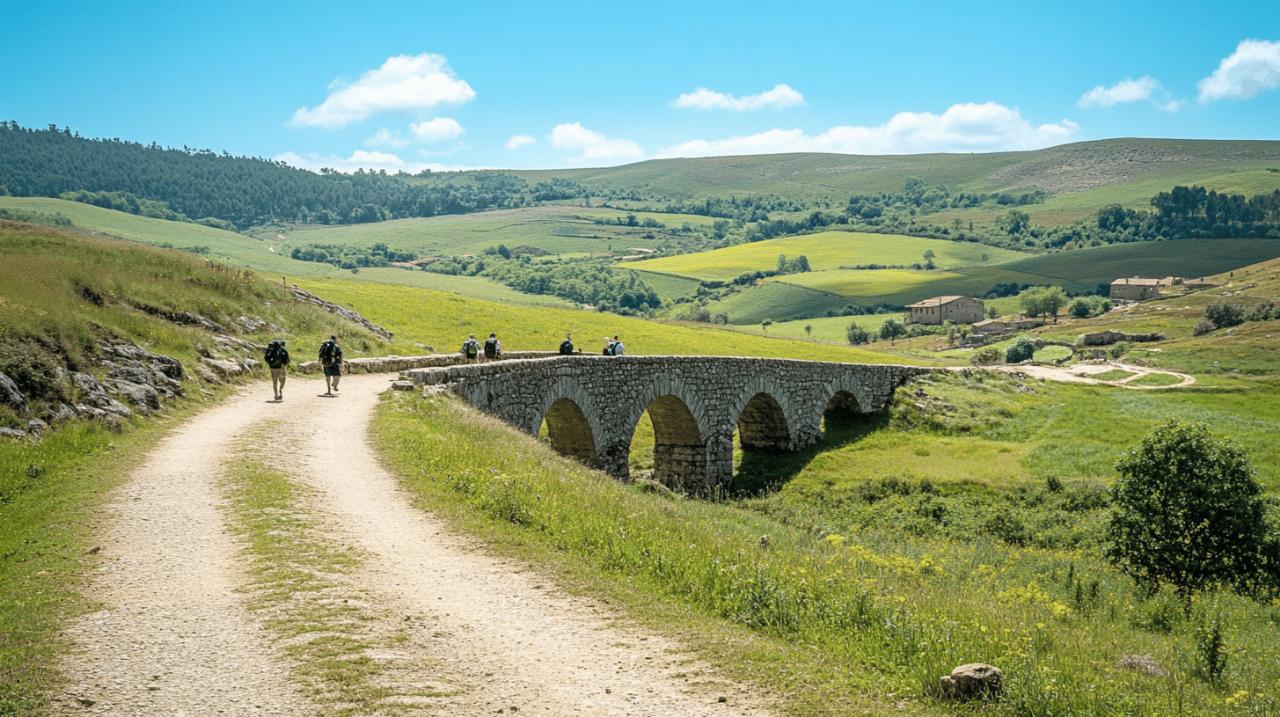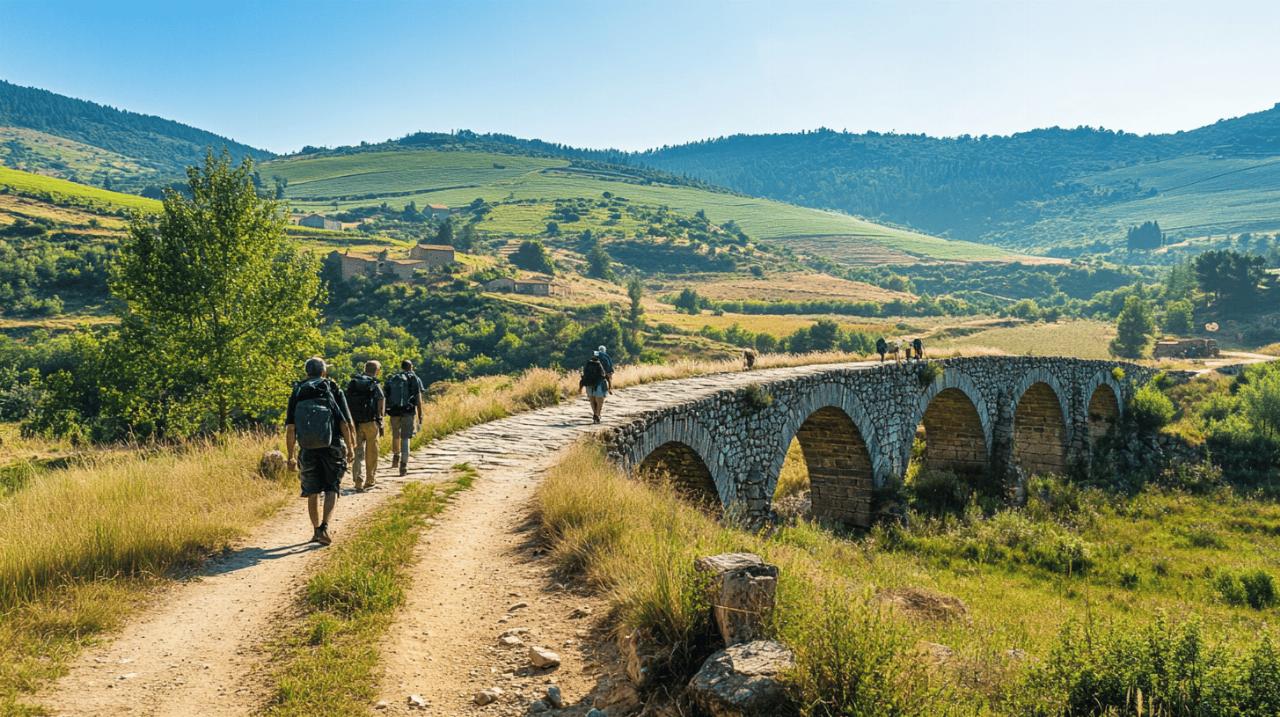Paws on the Path: Discover the Camino de Compostela Stage by Stage – Road Trip Experience with Your Dog
Embarking on the historic Camino de Santiago isn't just a spiritual journey for humans; it can also be a memorable adventure for our four-legged companions. The ancient pilgrimage routes that wind through France and Spain offer breathtaking landscapes and cultural experiences that both you and your canine companion can enjoy together – particularly when approached as a flexible road trip rather than a traditional walking pilgrimage.
Planning your canine-friendly camino road trip
Planning a Camino de Santiago experience with your dog requires careful consideration to ensure both you and your furry pilgrim have a comfortable and enjoyable journey. The Camino Frances route is often recommended for dog owners due to its well-established services and relatively manageable terrain. However, the Portuguese Way also presents excellent options with numerous pet-friendly accommodations along its path. When mapping out your road trip itinerary, it's crucial to balance your sightseeing aspirations with your dog's needs for rest and exercise.
Selecting dog-appropriate stages and stops
The beauty of experiencing the Camino de Santiago as a road trip with your dog is the flexibility it offers. Rather than committing to the traditional 25km daily walking stages, you can drive between locations and explore each area at a pace that suits your four-legged friend. Consider planning your itinerary around areas with ample green spaces where your dog can stretch their legs. The spring and autumn months typically offer the most pleasant temperatures for canine travellers, avoiding both the scorching summer heat and cold winter conditions that could be uncomfortable for your pet. When selecting daily excursions from your base, be mindful of terrain challenges that might be difficult for your dog, such as steep rocky sections or areas with limited shade.
Essential packing for your four-legged pilgrim
Preparing your canine companion for the Camino journey requires thoughtful packing. Your dog's travel kit should include portable food and water bowls, a secure lead, paw protection boots for rough terrain, and a comfortable travel bed. Documentation is equally important – ensure you have your pet's passport containing microchip information, vaccination records, and deworming certificates. For larger dogs, consider a specially designed dog backpack where they can carry some of their own supplies, though be careful not to overload them. A first aid kit with dog-specific items is essential, including paw cream to soothe tired pads after explorations. Rather than carrying excessive amounts of dog food, research pet shops along your route where you can purchase supplies as needed, though keeping a few days' worth on hand is advisable for remote areas.
Starting in France: Puy-en-Velay to the Spanish Border
Beginning your Camino road trip in the picturesque French town of Puy-en-Velay provides an authentic starting point that many walking pilgrims also choose. This remarkable town, with its volcanic pinnacles topped by religious monuments, offers an atmospheric introduction to your journey. The surrounding green spaces provide excellent opportunities for your dog to explore while you absorb the historical significance of this pilgrimage starting point. As you drive through the French countryside following the traditional Camino route, you'll discover that many areas are surprisingly accommodating to four-legged travellers, though advance research is essential as pet policies can vary widely in rural France.
Navigating french villages with your furry companion
The French section of the Camino presents unique considerations for dog owners. Many of the charming villages along the route feature narrow medieval streets and small squares where locals and visitors gather. When exploring these areas with your dog, it's important to keep them on a lead and be respectful of local customs. French cafe culture often welcomes well-behaved dogs in outdoor seating areas, providing opportunities to rest and refresh while maintaining your connection to the Camino experience. Be particularly vigilant when passing through farming areas with livestock, as encounters with working dogs can sometimes be challenging. The French countryside offers abundant natural beauty for you and your dog to enjoy, but remember that during summer months, planning your explorations for early morning or evening helps avoid the midday heat that can be uncomfortable for your pet.
Dog-friendly accommodations in medieval conques
The medieval village of Conques represents one of the most magical stops along the French section of the Camino. This extraordinarily preserved settlement, dominated by its magnificent abbey church with remarkable Romanesque carvings, deserves at least an overnight stay. Several small hotels and guesthouses in and around Conques welcome canine guests, though booking well in advance is essential as pet-friendly options can be limited. The village itself, with its cobbled streets and ancient buildings, provides a fascinating exploration experience for both you and your dog. The surrounding wooded valleys offer excellent walking opportunities where your dog can enjoy nature while you connect with the spiritual aspect of the Camino journey. Evening mealtimes may require some planning, as not all restaurants welcome dogs, but many establishments with outdoor terraces will accommodate well-behaved pets, allowing you to sample the delicious regional cuisine of the Aveyron area.
Crossing into Spain: Bilbao and Beyond
 As your Camino road trip crosses the Pyrenees into Spain, the cultural landscape shifts along with the physical terrain. Bilbao, though not directly on the traditional Camino Frances route, makes an excellent deviation for dog owners due to its combination of urban amenities and green spaces. The city's famous Guggenheim Museum provides a striking contrast to the medieval churches and monasteries that characterize much of the Camino route. While your dog cannot enter the museum itself, the surrounding area features sculptural gardens and riverside walks where you can stretch your legs together before continuing your journey into the heart of northern Spain. Spanish regulations regarding dogs tend to be more structured than in France, so keeping your pet on a lead in urban areas is not just courteous but often mandatory.
As your Camino road trip crosses the Pyrenees into Spain, the cultural landscape shifts along with the physical terrain. Bilbao, though not directly on the traditional Camino Frances route, makes an excellent deviation for dog owners due to its combination of urban amenities and green spaces. The city's famous Guggenheim Museum provides a striking contrast to the medieval churches and monasteries that characterize much of the Camino route. While your dog cannot enter the museum itself, the surrounding area features sculptural gardens and riverside walks where you can stretch your legs together before continuing your journey into the heart of northern Spain. Spanish regulations regarding dogs tend to be more structured than in France, so keeping your pet on a lead in urban areas is not just courteous but often mandatory.
Balancing city exploration and doggy downtime
Spanish cities along the Camino route require a thoughtful approach when travelling with a canine companion. The cultural rhythm of Spanish life, with its later dining times and afternoon siestas, can actually work well for dog owners. Morning explorations allow you to visit key sites before the heat of the day, while afternoon rest periods give your dog valuable recovery time. Many Spanish cities feature generous parks where local dog owners gather in the cooler evening hours, providing both exercise opportunities for your pet and chances to connect with locals who often have excellent advice about pet-friendly establishments. Remember that Spanish transport systems have specific restrictions – dogs weighing more than 10kg cannot travel on public transport, reinforcing the advantages of experiencing the Camino as a self-driven road trip when accompanied by a medium or large breed dog.
Discovering pet-welcoming tapas spots and green spaces
The Spanish tradition of tapas dining can be particularly compatible with dog ownership during your Camino journey. Many establishments feature outdoor terraces where well-behaved dogs are welcome, allowing you to sample local specialties while keeping your furry companion by your side. Cities like León and Burgos along the Camino Frances route offer excellent combinations of historical sites and green spaces. León's magnificent cathedral can be admired from its adjacent plaza where your dog can rest while you appreciate the architecture, while Burgos features a lovely riverside park perfect for canine exercise. The APACA association maintains updated information about dog-friendly establishments along various Camino routes, making it an invaluable resource for planning your accommodations and dining experiences. Social media communities dedicated to dog-friendly travel in Spain can also provide current recommendations and warnings about areas where pet access might be restricted.
Reaching santiago: a shared achievement
Arriving in Santiago de Compostela with your canine companion represents the culmination of your shared Camino journey. The city, with its magnificent cathedral and medieval streets, welcomes thousands of pilgrims annually, though navigating it with a dog requires some additional planning. The large public squares surrounding the cathedral offer excellent vantage points to appreciate the architectural splendor while keeping your dog comfortable in an outdoor setting. Santiago has embraced its role as a pilgrimage destination for diverse travellers, including those with four-legged companions, and the city features several pet-friendly accommodations within walking distance of the main cathedral complex. The surrounding parks and green spaces provide pleasant environments for your dog to recover from the journey while you reflect on the experiences you've shared along the way.
Finding Dog-Friendly Ways to Experience the Cathedral
While your dog cannot enter the Cathedral of Santiago itself, there are numerous ways to share the spiritual culmination of the Camino journey together. The large Praza do Obradoiro in front of the cathedral serves as a gathering place for pilgrims and provides an excellent spot to appreciate the cathedral's Baroque façade with your dog by your side. Early mornings offer the most peaceful experience of this space before the daily influx of visitors. Several cafés with outdoor seating around the cathedral square welcome dogs, allowing you to linger and absorb the atmosphere while keeping your pet comfortable. For those seeking a more comprehensive understanding of the cathedral's interior, some accommodations offer dog-sitting services for a few hours, allowing you to visit the cathedral while ensuring your companion is safely cared for.
Commemorating your journey: paw prints and pilgrim credentials
The traditional culmination of the Camino involves receiving the Compostela certificate, but innovative developments now allow your dog to receive recognition too. The Perregrina certificate is specifically designed for canine companions who have completed the journey, creating a meaningful memento of your shared experience. To qualify, you'll need to have maintained a Canine Credential throughout your journey, similar to the human pilgrim passport that collects stamps along the way. This documentation provides a wonderful keepsake of your adventure together. Many pilgrims with dogs create additional commemorations, such as paw print impressions beside their own handprints or special photo collections documenting their shared experiences along the route. Local artisans in Santiago often create custom mementos featuring pilgrim symbols adapted to include canine elements, offering unique souvenirs of your dog-friendly Camino road trip that celebrate the bond strengthened through your shared journey across France and Spain.
